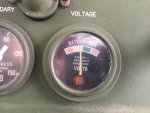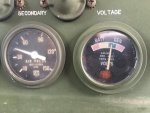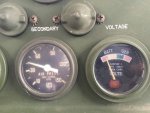74M35A2
Well-known member
- 4,145
- 330
- 83
- Location
- Livonia, MI
Hope everybody had a good Christmas.
I have received a few questions on dash voltmeter readings after alternator replacement with non-stock units, so I took a few minutes to capture some photos of my system for reference.
The stock Leece-Neville alternator has a screwdriver adjustable voltage. It then becomes fixed regardless of temp. More modern Delco and other brand alternators now typically use a non-user adjustable voltage regulation curve, which is temperature compensated. Let's say by approximately 0.1V per 10 degrees. This allows for a higher recharge voltage in colder temps, because there is less possibility of boiling the battery electrolyte in colder temps, and vice-versa in warmer climates. Same with extended running in any climate, the longer it is used, the warmer the batteries and alternator become, and the voltage regulation setpoint drops. All of todays vehicles including trucks are like this.
Please find below pics of the volt gauge in my 1990 M925A2. I have a genuine Delco alternator, modern gear reduction starter, and two standard flooded type lead acid group 31 batteries made by Johnson Controls ($100 each, new) that are less than 1 year old, and have never been allowed to go full dead.
The truck has sat not started for 3 days, and was driven for 5 hours 3 days ago. Current ambient temp is 50F. The first pic is with both dash switches on, engine not running. This is just pure battery voltage. Second pic is engine started, alternator cold but working. Third picture is voltage during cranking. I pulled the engine stop amd cranked it for 10 seconds, and took the pic while cranking. This would be a load test type condition.
I don't have any digital voltmeter data to accompany this, so it is really only half useful, but it will give you an idea of what a healthy system should read like. I am not sure of the voltmeter accuracy amongst trucks, so again, take that with a grain of salt. A single 12v fully charged lead acid battery will read 12.8V, so 25.6v doubled up. 12.0V is 80% discharged. Take note of this. I am picky about batteries and replace them every 5 years no matter what. Cost to do so is only $200, total. Anything over 25.6v is charging. When my alternator is warm from running a while, my volt needle will be nearly on the yellow/green border.
This can become more scientific via electrolyte specific gravity and all that, but for general shade tree diagnostics, this is a good place to at least start. I will later update this with typical cranking current and battery recharge time graphs so it is more useful yet.
If your engine-off voltage shows less than this, your batteries are low on charge. Your engine running voltage will be less than the middle pic as the alternator warms. I do not have any charge curve data for the popular $70 Chinese Delco clone 24v alternators, but it may be similar, or just a fixed voltage regardless of temp. These are easily identified as they do not have "Delco Remy" cast into the back side of the rear frame of the unit.



I have received a few questions on dash voltmeter readings after alternator replacement with non-stock units, so I took a few minutes to capture some photos of my system for reference.
The stock Leece-Neville alternator has a screwdriver adjustable voltage. It then becomes fixed regardless of temp. More modern Delco and other brand alternators now typically use a non-user adjustable voltage regulation curve, which is temperature compensated. Let's say by approximately 0.1V per 10 degrees. This allows for a higher recharge voltage in colder temps, because there is less possibility of boiling the battery electrolyte in colder temps, and vice-versa in warmer climates. Same with extended running in any climate, the longer it is used, the warmer the batteries and alternator become, and the voltage regulation setpoint drops. All of todays vehicles including trucks are like this.
Please find below pics of the volt gauge in my 1990 M925A2. I have a genuine Delco alternator, modern gear reduction starter, and two standard flooded type lead acid group 31 batteries made by Johnson Controls ($100 each, new) that are less than 1 year old, and have never been allowed to go full dead.
The truck has sat not started for 3 days, and was driven for 5 hours 3 days ago. Current ambient temp is 50F. The first pic is with both dash switches on, engine not running. This is just pure battery voltage. Second pic is engine started, alternator cold but working. Third picture is voltage during cranking. I pulled the engine stop amd cranked it for 10 seconds, and took the pic while cranking. This would be a load test type condition.
I don't have any digital voltmeter data to accompany this, so it is really only half useful, but it will give you an idea of what a healthy system should read like. I am not sure of the voltmeter accuracy amongst trucks, so again, take that with a grain of salt. A single 12v fully charged lead acid battery will read 12.8V, so 25.6v doubled up. 12.0V is 80% discharged. Take note of this. I am picky about batteries and replace them every 5 years no matter what. Cost to do so is only $200, total. Anything over 25.6v is charging. When my alternator is warm from running a while, my volt needle will be nearly on the yellow/green border.
This can become more scientific via electrolyte specific gravity and all that, but for general shade tree diagnostics, this is a good place to at least start. I will later update this with typical cranking current and battery recharge time graphs so it is more useful yet.
If your engine-off voltage shows less than this, your batteries are low on charge. Your engine running voltage will be less than the middle pic as the alternator warms. I do not have any charge curve data for the popular $70 Chinese Delco clone 24v alternators, but it may be similar, or just a fixed voltage regardless of temp. These are easily identified as they do not have "Delco Remy" cast into the back side of the rear frame of the unit.



Last edited:


